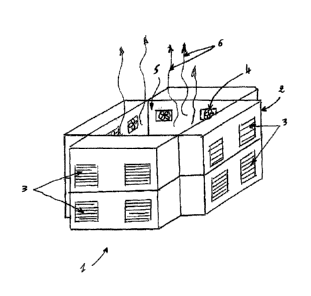Une partie des informations de ce site Web a été fournie par des sources externes. Le gouvernement du Canada n'assume aucune responsabilité concernant la précision, l'actualité ou la fiabilité des informations fournies par les sources externes. Les utilisateurs qui désirent employer cette information devraient consulter directement la source des informations. Le contenu fourni par les sources externes n'est pas assujetti aux exigences sur les langues officielles, la protection des renseignements personnels et l'accessibilité.
L'apparition de différences dans le texte et l'image des Revendications et de l'Abrégé dépend du moment auquel le document est publié. Les textes des Revendications et de l'Abrégé sont affichés :
| (12) Brevet: | (11) CA 2845492 |
|---|---|
| (54) Titre français: | INFRASTRUCTURE TECHNIQUE DE CENTRE DE DONNEES |
| (54) Titre anglais: | DATA CENTER TECHNICAL INFRASTRUCTURE |
| Statut: | Octroyé |
| (51) Classification internationale des brevets (CIB): |
|
|---|---|
| (72) Inventeurs : |
|
| (73) Titulaires : |
|
| (71) Demandeurs : |
|
| (74) Agent: | BCF LLP |
| (74) Co-agent: | |
| (45) Délivré: | 2017-05-30 |
| (86) Date de dépôt PCT: | 2012-08-20 |
| (87) Mise à la disponibilité du public: | 2013-02-28 |
| Requête d'examen: | 2014-09-08 |
| Licence disponible: | S.O. |
| (25) Langue des documents déposés: | Anglais |
| Traité de coopération en matière de brevets (PCT): | Oui |
|---|---|
| (86) Numéro de la demande PCT: | PCT/FR2012/051913 |
| (87) Numéro de publication internationale PCT: | WO2013/026985 |
| (85) Entrée nationale: | 2014-02-14 |
| (30) Données de priorité de la demande: | ||||||
|---|---|---|---|---|---|---|
|
Infrastructure technique (1) de centres de données, comprenant une pluralité de salles (2) informatiques, caractérisée en ce que les salles (2) sont agencées en forme de cheminée dont la cavité (5) est ouverte vers le haut.
Technical infrastructure (1) for data centers, comprising a plurality of
computer rooms (2), characterized in that the rooms (2) are arranged in the
shape of a chimney, the cavity (5) of which is open upwards.
Note : Les revendications sont présentées dans la langue officielle dans laquelle elles ont été soumises.
Note : Les descriptions sont présentées dans la langue officielle dans laquelle elles ont été soumises.

Pour une meilleure compréhension de l'état de la demande ou brevet qui figure sur cette page, la rubrique Mise en garde , et les descriptions de Brevet , États administratifs , Taxes périodiques et Historique des paiements devraient être consultées.
| Titre | Date |
|---|---|
| Date de délivrance prévu | 2017-05-30 |
| (86) Date de dépôt PCT | 2012-08-20 |
| (87) Date de publication PCT | 2013-02-28 |
| (85) Entrée nationale | 2014-02-14 |
| Requête d'examen | 2014-09-08 |
| (45) Délivré | 2017-05-30 |
Il n'y a pas d'historique d'abandonnement
Dernier paiement au montant de 263,14 $ a été reçu le 2023-08-01
Montants des taxes pour le maintien en état à venir
| Description | Date | Montant |
|---|---|---|
| Prochain paiement si taxe générale | 2024-08-20 | 347,00 $ |
| Prochain paiement si taxe applicable aux petites entités | 2024-08-20 | 125,00 $ |
Avis : Si le paiement en totalité n'a pas été reçu au plus tard à la date indiquée, une taxe supplémentaire peut être imposée, soit une des taxes suivantes :
Les taxes sur les brevets sont ajustées au 1er janvier de chaque année. Les montants ci-dessus sont les montants actuels s'ils sont reçus au plus tard le 31 décembre de l'année en cours.
Veuillez vous référer à la page web des
taxes sur les brevets
de l'OPIC pour voir tous les montants actuels des taxes.
Les titulaires actuels et antérieures au dossier sont affichés en ordre alphabétique.
| Titulaires actuels au dossier |
|---|
| OVH |
| Titulaires antérieures au dossier |
|---|
| S.O. |